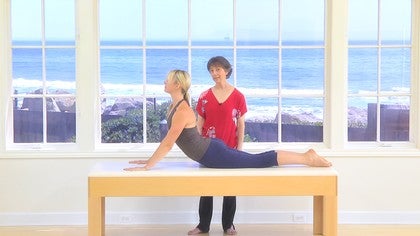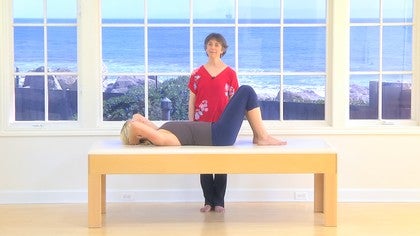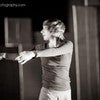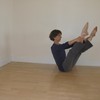Description
About This Video
Transcript
Read Full Transcript
Hi, I'm Ruth Alpert, and this is Leah Longly, who's going to be my demo. Today we're going to talk about abs, which are a major part of Palladio's work and very often misunderstood as the only part of Polonius work. Polonius is a lot more than your abdominal muscles, but uh, they are used in a very particular way. And so we're gonna focus on that today. Generally, your ab muscles are, consists of four different sets of muscles, the transversus, which is the deepest layer and goes horizontal and girds your pelvis. It does what a girdle does or what they made girls to mimic. For those of you of my generation who remember what girls are, I forget who I'm speaking to here. Um, think of a big piece of elastic wrapping around.
The next two layers are the obliques, internals, and externals. And they create a crisscross. And then you have your rectus abdominis in front, which is basically a soft spine, the six pack right in men, um, who are really buff. You can see it in sections and it's a very, very big thick muscle. If it were bone, we wouldn't be able to move much at all. So the body was brilliant in designing it as a very thick core support, but soft enough to be flexible. And the, the, um, rectus has to mimic your spine, right? You want the two to work together because it is a soft spine in your front. We'll talk about that more in, in a moment. And all together, the abs basically cover everything that is not bone in your belly and into the sides of you.
They attach all along your pelvis and at different places on your ribs. And I like to think of the abs as the pie crust. They're there to hold your organs in, right? You know, you've got like your base crust and then the apples and the apples are your intestines and your pancreas and your stomach and all your different organs. And then the abs or the covering there. Literally the pie crust that keeps the organs in your pelvis and where they belong. And you can see that in um, uh, people with big beer bellies where the abs are distended and the organs are little literally starting to fall out. So, um, I'm gonna Start by telling you a story.
I like stories. I was teaching PyLadies for already a number of years and I have a wonderful friend who's a gorgeous, gorgeous dancer. She specializes in, uh, classical dance from Uzbekistan and Middle Eastern dance. And I was working for Raul for, and we were specializing in car accidents and my friend had had an accident and so she was able to come do Polonius with me as part of her medical payment on the car insurance. And the very first lesson I do with anybody, including all of you at home is let me see how you pull in your abs to show me what you do when you think of contracting your ab muscles. Because many of us, we're taught some very curious ways of pulling in our abs. That's not always useful.
So I say this to my friend and she goes, these apps, or these apps or these apps or these apps, she gave me six different variations from her belly dance background. I don't know, I'm just looking at her going, you know, whatever it was at that point, 12 years of teaching [inaudible] and I had never had that response to pulling in abs. And curiously enough, actually the ABS that we use in [inaudible], we're not any of the ones that she was demonstrating. Um, so I'm here to say that there are many ways to use your abs. There is no one right way to use your abs. There is just what's appropriate for doing PyLadies and for hauling pianos. And there's other uses of your abs if their expression in various forms of dance. So having said that much, Leo's gonna lie down and I'm going to say to her what I say to all of you, show me an ad contraction. What do you do when you pull in your abs?
And what we want in [inaudible] is the abs to be able to draw in without a particular bone action. So many of you, I know my generation in the sixties and seventies we were all taught to pulling our abs by pressing our back down to the floor and tucking our pelvis, which Leah will now demonstrate because if you leverage off your bones, your abs will definitely scoop up and you'll feel like you're working your abs, but they're not really working that hard. Mostly you're using your bones to access your muscles, so if you leave your bones alone and just pull in your abs, there she goes. Beautiful. That is the, the girding, that's the girding, the deepest layer of the abs that we need to use here. What many? There's another use of your abs, which you do hopefully every day, and that's pushing your abs when you're sitting on the toilet or having a baby, which I hope you don't have a baby every day, but you'll hopefully do sit on the toilet every day. So Leah has had a baby, so pretend you're giving birth and pooch out. Good. That is technically an abdominal contraction, so it is. You're right, if you're contracting your abs and doing that, but it's not useful for Palazzos because to go back to that image of your spine and your soft spine, the Rectus, when you pooch, you're pulling the muscles away and your spine will either go with you and hyperextend or the the your back muscles will go into high gear to counterbalance so you don't fall forward. And then you've set up an argument in your nervous system and in your body and everything you do is going to hurt.
And I have a personal theory that Palladia should be challenging but not painful. So back to the ABS U s we call it a scoop because the feeling is that you're being scooped out and there's a slight upward energy to it.
I like having my hands actually a little here. You could maybe one up and one down because very often you'll feel the bulk of the work at the ends more than in the middle. Now you can add to this bone movement, but you want to be able to access your abs totally by themselves. So if we want to add a tail curl, you're gonna Scoop your belly and curl your tail and a little more, you can make a little bigger good and go back down and scoop your abs and then add your tail curl. So they don't, they're not married to each other because you're going to have to find your abs even when you're arching.
And if you've programmed in your ad contraction to a particular shape of your spine and pelvis, you're going to be in trouble later. Take it from me. I want to go over a few of the ways that the common ways that people use or abs that uh, can get you in trouble later on. So one of the things that very often when I ask people to pull in their ads, what I see if you're not on the Middle Eastern Dancer, is people stick their ribs out. Because when you stick your ribs out, it's going to hollow out your belly and that's going to feel like your abs working.
But actually all you're doing is because the muscles are all attached here. You're just stretching them, which is cheating. You're not going to get strong that way. So I recommend that when you're starting to do this ab work, especially on your back, that you do the hissing exhale and you make the letter s which will let your breath go out more slowly and let let your ribs come down and at the very bottom of the hiss you'll feel something engaging here and then inhale normally and exhale and feel your ab contraction, which is a natural event at the bottom of your exhale. Another thing that many people do, and again, we've all been taught to do this of a certain generation, you find your abs by tucking your pelvis or pressing your back down into the floor, right and release and press it down.
Good. Another famous, you said the ABS, which also is not going to support you when you have to hang upside down by your pinkies is pooching. Now in [inaudible] we have very technical language. We call it scooping for the correct use of your abs and pooching when it's sticking out. So you'll see this a lot in gyms. You know people doing crunches, I'm sorry, I have to beg to differ. I worked for Raul for doing Polonius with people who had been in car accidents for five years. At one point in my teaching life, crunching is what a car does. When another car hits it.
Crunching is what your body does when you're in that car getting hit. Why would you want to crunch your body when it doesn't have to crunch? So I like thinking of it more as a curl up rather than a crunch, but my opinion, so when you're curling up, go ahead and and class. What very often happens is people use a lot of force [inaudible] and the rectus bulges and go back down. Yes, technically that is an ab contraction, but not the kind you want. Purple oddities or lifting pianos. So one more time.
She's going to crunch and grit and, and grab good and go down. Which brings me to another thought. Rest your arms. There are gradations of Ab contraction, gradations of energy. So I like to use the Richter scale because of course we're in California and that's well known here. So 10 on the Richter scale would be full out ABS. You know, you're doing something like teaser or something very, very rigorous and you need all the abs you've got and that's your full ab contraction. And it happened.
It's a drawing in of your muscles. It's totally under your control. There is no force. Even when you get to 10 on the Richter scale, your abs are being drawn in without force. And there are some exercises where you need add consciousness, but you might not need let, let's say your knees are going side to side, right? Or you're doing some elbow circles. So grab your elbows and right, you want your abs to be awake and part of your body and in the picture, but they're not lifting anything. So you don't need to overwork them.
So then there may be one or two on the Richter scale, but they're connected rather than full out work. Good things that snuff. Um, so that idea that your abs are under your control and you can choose the degree of which they work, but they're never just a contraction that grips and stays in one place. It's always a movement. Your abs are a movement like any other muscle movement. Okay? So another way to feel your abs, uh, is for your head to curl up.
So support your head by clasping your hands and begin to curl your upper body up and you will feel beautiful. Yes, keeping your pelvic bones nice and solid. Good. And Go back down. Do that a few times. Easy to do on an exhale. So at the beginning level, I would suggest you exhale on the way up because your Xcel sends your ribs down. And part of that, the I'm good and come back down. So the anatomical purpose of your abs, according to Grey's anatomy, uh, they have a number of purposes, but one of the big one is, is because they're attached to your ribs, they're going to pull your ribs down for exhaling when they contract.
Another purpose of your abs is to put pressure on your organs. So if you've just eaten and then you come to a place class, or actually any physical exercise. And if they had told me that when I was seven years old and kept saying, can I go in the water yet? And My mother kept saying, no, not yet. The whole idea of waiting an hour after eating is because you're ad contraction and you're a deeper breathing will put pressure on your stomach and your intestines and the other organs. And if you had chicken salad in your sandwich, that chicken is going to want to get back to the ranch. So another way to find your abs is in an exercise that I learned from my teacher, Michelle Larson called pregnant cat.
So come up onto all fours. So you're on all fours. There's going to be absolutely no spine movement or pelvis movement. You have a belly full of kittens. So drop your belly, let your belly stick out. There it is. And look, she gave birth. No kittens, pull him up on God, no more kittens. And then by the way, you can't really pull in your abs and giggle at the same time. So abs drop out and pull them in and notice how stable her pelvis is.
She's not doing the cat cow, um, exercise that many of you know, although why it's called the cow beats me. I've never seen a hyper extended cow should be cat horse, but that's another exercise. Good. And a few more times. So our belly drops out and then it pulls up, belly drops out and then pull it up. Beautiful. You'd be really surprised how strong your abs can get just by doing a little bit of this every day. Another place to feel your abs is prone.
And also in arching, and this is why earlier I was really adamant that you find your ab muscle contraction as a unique movement so that you can apply them, whether you're arching or curling or in the advanced work doing something kamikaze, like a handstand from the top of the Cadillac or some exercise where you cannot afford to let go of your abs for one second, but you also have to have a very free and flexible spine. So a good way to to play with this is to go belly down, face down on your mat and just relax how, let everything hang out and then just pull your belly away from the floor. But again, without moving your pelvis so much that it becomes a distortion. There's probably a better way to say that. So pull up in your belly there she goes and relax completely and just let it relax. Just nothing.
And then pull up in your abs and you'll feel it and maybe you can see it along the sides here because the transversus abdominis, the bulk of that muscle is really along your sides more than in the front. So again, take a close look, she'd totally relaxes and then she scoops up, finds her scoop, and there's a little indentation in this area. Now demonstrate too much. If you pull in your abs and your whole pelvis moves, that's not okay. That's actually putting a lot of tension and pressure in your lumbar.
Do a couple more times like that,
That usually hurts people. Now pull up your apps and do you see how that changes the support through her shoulders and changes almost the position of her pelvis. So do that a few times. Sag Out, unhappy spine, pull up, happy body. Drop out. Well, pull up. Supported. Thank you very much.
I wanted to just add one piece that you can play with your abs anytime you want. You'll never be bored again. Red Lights, great place. You're sitting at a red light, your hands are on the wheel, and you scoop and relax and the school and relax. Meetings where you're bored, standing in line at the grocery store, you always have the option to go into your body. And because it's a subtle movement, nobody can see that you're doing it and you'd really be amazed.
I know I said this already, but often I'll give this to people to do in between their first few lessons and they'll come back a week later with their abs already much stronger just from sitting here scoping. So thank you for watching. If you have any questions or any dialogue you want, I'm very happy to answer questions on the forum that, uh, we'll show with this video and go play with your abs.
The Successful Beginner: Movement Breakdowns
Comments
And hi Heather! long time! so glad you liked it.
Ps
Take a look around 20:50 in the back round in the ocean- a sea otter decided to listen in.
Should me address sometmes the perinal muscle work to have stronger abs? I like your turorial and how you approach the subject.
You need to be a subscriber to post a comment.
Please Log In or Create an Account to start your free trial.
































